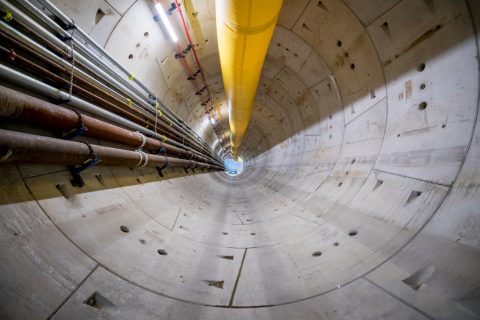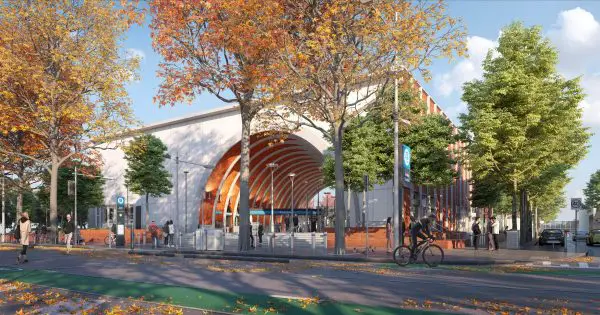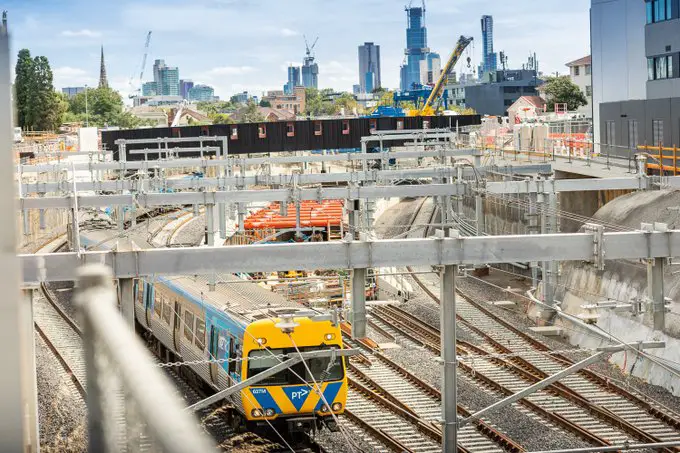Latest Oct 2023
Sydney Metro Rapid Transit System in New South Wales, Australia
Arden Precinct Metro Station, the first of the five Metro Tunnel stations for Melbourne Metro is well on track for completion before the end of 2023.
The station features Victorian-first platform screen doors, a soaring brick arched entrance and skylights allowing natural light to flow 14m underground to the concourse and platform. It sits on a former industrial site approximately two kilometres from the centre of Melbourne’s CBD. Noteworthy, Arden is a central and connected precinct that will be home to up to 34,000 jobs and around 20,000 people by 2051.
Metro Tunnel Project Overview
The Metro Tunnel, earlier known as Melbourne Metro 1 or Melbourne Metro Rail Project is a metropolitan rail infrastructure scheme currently under construction in Melbourne, Australia. It comprises the construction of two 9-kilometre rail tunnels with five new underground stations from South Kensington station, northwest of Melbourne City to South Yarra which is in the southeast).
The tunnel will join the Pakenham and Cranbourne lines to the Sunbury line, allowing them to bypass Flinders Street station and the City Loop and also stop at the Melbourne central business district. The Metro Tunnel will allow for the operational separation of a number of existing lines and raise the capacity of the rail network to metro-style frequencies. The scheme is part of the PTV Network Development Plan.
Read also: Northwind Global City project in Bulacan, Philippines.
10 facts about the Melbourne Metro Tunnel, the biggest rail project in Victoria, Australia
- The metro tunnel includes the construction of twin 9-kilometre rail tunnels. The tunnels will be between South Kensington (northwest of the Melbourne central business district) and South Yarra (in the southeast).
- The project also includes the construction of five new underground stations.
- The tunnel will connect the Pakenham and Cranbourne lines with the Sunbury line. As a result, the Melbourne Metro Tunnel will create a new cross-city line that bypasses Flinders Street station and the City Loop.
- The tunnel is also planned to serve Melbourne Airport through a new branch line west of Sunshine Station.
- The state government of Vitoria began planning for the project in 2015 while the enabling works commenced in early 2017.
- Tunnelling works began in 2019 and was completed in 2021.
- The Melbourne Metro Tunnel project was originally expected to be completed in 2026. However, the completion date has been brought forward to 2025.
- The project was developed by Rail Projects Victoria, which was formerly known as the Melbourne Metro Rail Authority, at an estimated cost of $9 to $11 billion.
- Once operational, the metro tunnel will serve a total of 39,000 passengers per day with a further 41,000 extra passengers if 10-car trains are introduced.
- The project provided 3,500 people during peak construction and trained over 500 apprentices, trainees and engineering cadets.
Melbourne Metro Tunnel Project Timeline
2015
In February, the State government formed the Melbourne Metro Rail Authority, with funding worth $40 million, to supervise the planning of the project $1.5 billion to start land and property acquisitions and detailed route investigation, and an additional $3 billion in funding was dedicated.

Most of the scheme would be constructed on a public-private partnership, with private-sector investors financing much of the estimated $9 billion to $11 billion cost upfront. Early enabling works started in late 2016.
2017
Late in, parts of the Melbourne central business district, with City Square and sections of Swanston Street, were shut to enable the tunnel construction and stations. The project was earlier planned to be completed in 2026 but was later revised to late 2025.
2019
From April to July, a number of rail lines in Melbourne’s east were closed for weeks for tunnel entrance construction near Kensington and South Yarra. The first tunnel boring machine assembling started in North Melbourne in June.
2020
In February, the first section of the Metro Tunnel between Arden and Kensington was completed by TBM Joan, 1.2 kilometres long and installed 4,200 curved concrete segments to offer 700 rings lining the tunnel walls.
Two months later, TBM Meg accomplished the accompanying tunnel, between Arden and Kensington. The third, TBM Millie, started tunnelling to the South Yarra eastern tunnel entrance on 27 April. It was later lowered underground, as part of the process and assembled along with her mate TBM Alice and will tunnel 1.7 kilometres to its destination.
TBM Alice was released a month later, on 25 May.TBM Joan started tunnelling again, now towards Parkville, from Arden, on 25 May. The release of TBM Meg towards Parkville revealed that for the first time in the scheme, all four TBMs were tunnelling at the same time.
In May, major traffic changes were established around Flinders Street Station in order to increase safety because of the project’s large trucks entering acoustic sheds.
They included the removal of Left turns between St Kilda Road and Flinders Street, and the closure of the pedestrian crossing from St Paul’s Cathedral to Federation Square. The crossing is likely to reopen in January 2022.

2021
On 24 May, it was stated that all four TBMs had accomplished digging the twin 9km tunnels. The work was estimated at an average rate of 90m per week on all four TBMs.
The next Metro Tunnel construction phase includes the tunnelling of 26 cross passages. The cross passages are short tunnels that join the main tunnels for passengers when an incident occurs.
Nov 2021
The work was almost complete on the guiding 60-tonne concrete and brick arch segments into place to offer the soaring entrance for the Arden Station, a section of the Metro Tunnel. The work began with the installation of seven support columns in June, followed by the building of a temporary steel frame to offer support to the arches for the lowering into place. The first on the arches, modelled to show the rich industrial history of North Melbourne was fixed in mid-October using a 350-tonne crane.
The work is expected to be completed by the end of this year. The 15 arches are manufactured from precast concrete lined with over 100,000 bricks, each one laid using hand. They consist of 45 individual segments, each weighing around 60 tonnes. The arches were being constructed from Victorian bricks at a precast factory in South Australia which is the only Australian business of the kind with the power to undertake such logistically challenging work.

They are being transported to the site using a flatbed trailer. Once done, the arches will rise around 15 metres above passengers as they enter the station from Laurens Street. Construction is also going well underground, with the last concrete pours for the station’s platform surfaces almost completed.
In the tunnels from Arden to the State Library Station sites, workers are pouring the concrete to make the tunnel floor slab. They are also installing equipment like cable brackets and trays which are also part of rail tunnel fit-out. The building for the station’s services is being installed internally in walls like plumbing, mechanical and electrical works.
Furthermore, work on collar beams with the concrete structures joining the edge of the tunnel to the station box located at the station’s eastern end.
Dec 2022
First Anzac Station for Metro Tunnel in Melbourne fully operational
The Metro Tunnel project in Melbourne, Australia, has marked a significant milestone with the completion of its first Anzac Station. The tram stop stretching along St Kilda Road is now fully operational and open to passengers.
The project had a dedicated workforce that worked for more than three weeks. The team working on it realigned the tram tracks on both sides of the main entrance to the underground train station near the shrine of remembrance.
The tram tracks on St Kilda Road underwent realignment three times. This way, the project will allow people to continue using the road uninterrupted, while construction carries on, below.
Expectations for the Metro Tunnel Project in Melbourne

The Anzac Station is expected to provide a direct train connection to iconic destinations within Melbourne. These include the Royal Botanic Gardens as well as the Shrine.
Read Also: Design contract awarded for Chatswood Tower project in Australia
Furthermore, the station will support taking pressure off the trams on Swanston Street, which is on the world’s busiest tram corridor. As a result, the Metro Tunnel will cut down travel times for well up to 33,000 people, more especially those who work around the St Kilda precinct.
Remarks on the project
Nina Taylor, a Member of Albert Park also commented on the project saying it is highly motivating to witness the milestone progress of the world’s busiest tram corridor.
The train station is continuing to take shape, Nina Taylor said, with the installation of electrical as well as mechanical systems. Additionally, infrastructural development works are well underway featuring escalators, and lifts, alongside security systems.
Moreover, the project will be accompanied by CCTV and passenger information displays. While commenting on the project, the Victorian Minister for Public Transport revealed that the trams will offer better amenities for passengers.
As a whole, Ben Carroll continued, the project strives to build a world-class public transport system that Victorians deserve.
Jul 2023
The Metro Tunnel Project Marks Milestone With Premier Test Runs in Australia
The first test trains entered the Melbourne Metro Tunnel, the biggest rail project in Victoria since the City Loop, in July 2023. The trains, two next-generation High Capacity Metro Trains, entered the twin 9-kilometre tunnels at the South Yarra tunnel entrance. They travelled approximately 1.7 kilometres to Anzac Station, directly under St Kilda Road, a journey that was years in the making.
This marks the start of the Melbourne Metro Tunnel project’s next major testing phase which will stretch into 2024. Over the coming months, crews will run trains back and forth between the 5 tunnel stations. The basics, such as lining the trains up with the platforms, will be tested first and then the team will gradually increase the complexity, from one train at low speed using minimal power to multiple trains at greater speeds.
Various equipment and systems will be tested to make certain that the Melbourne Metro Tunnel is safe and ready to open to passengers in 2025, a year ahead of schedule.
Aug 2023
